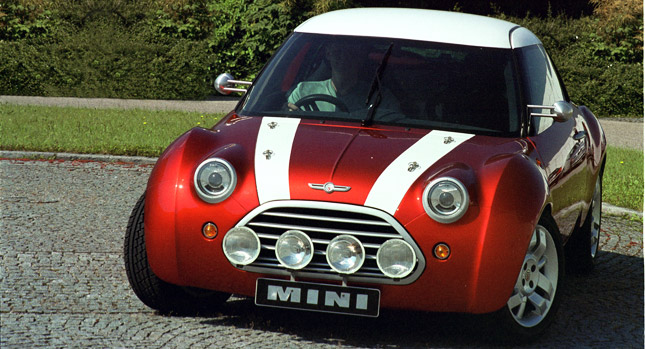For most people in the northern hemisphere, August is the last summer month of relaxation and freedom before the new season kicks in and we all return to reality.
What this means for most industries and especially the automotive sector, is that there is not a lot going on, which could explain why MINI chose this month to reminisce about its past concepts, from the moment it was acquired by the BMW Group in the mid-1990s to the present day.
All in all, MINI chose to remind us of a dozen design studies, from the 1997 Concept Monte Carlo Rallye to the updated version of the Rocketman hatch, some of which were destined for production like the Paceman, while others like the 2009 Beachcomber, simply to arouse interest at motorshow floors.
If you follow the jump, you will find pictures and a description of each model by MINI. If you feel up to it, you can tell us which concept is your favorite in the comments section below.
2012.
MINI Rocketman Concept.
This new edition of the MINI Rocketman Concept was conceived in 2012 and combines innovative ideas for personal mobility in major cities with classical, unmistakably British design features for the interior and exterior.
Decked out in the colours of the British national flag, the concept car features eye-catching details such as a distinctive lighting design for the Union Jack in the roof area. The MINI Rocketman Concept embodies sporting elegance in typical British form.
2011.
MINI Rocketman Concept.
This well received concept car fused traditional values with innovative technology to redefine MINI’s core principle of the creative use of space. As a 3+1-seater with 3 doors, an exterior length of just over 3 metres (approx. 10 ft.) and a unique space utilisation concept up its sleeve, this concept car shone a spotlight into the future.
Its visionary character was defined by the systematic application of lightweight design principles on a carbon spaceframe canvas.
2010.
MINI Paceman Concept.
MINI positioned this concept car – a classical crossover concept based on the MINI Countryman – as the first Sports Activity Coupé (SAC) in the premium segment.
The study’s dynamic and powerful, yet at the same time luxurious, appearance sent out a message of exclusive sportiness. Visually it had an air of the muscle car about it, showing off its dynamic credentials impressively from every angle.
MINI Beachcomber Concept.
This precursor to the MINI Countryman focused on maximising driving fun and boasted a radical, open-air body concept. A very masculine concept, it referenced the legendary Mini Moke from the 1960s and focused on highlighting various interior design features. At the heart of the action was the versatile Centre Rail, to which a MP3 player, mobile phone, additional light sources, a cool box, a laptop or GPS tracker, a stopwatch, a glasses case, a bottle holder or a food box could be attached.
MINI Scooter E Concept.
This electrically driven study took cues from the MINI E, a Germany-wide test project for emission-free driving. The MINI Scooter E Concept saw MINI Design transferring the brand’s central design language from four wheels to two for the first time, demonstrating in the process the potential of MINI.
Hallmark MINI details were reflected in three different design variants: one focused on “Britishness”, another on the Mod movement which is such an important part of scooter culture, and the third model adopted the appearance of the MINI E.
2009.
MINI Roadster Concept and MINI Coupé Concept.
In their own distinctive ways, the “Oxford Twins” showcased a wealth of exciting features offering a fresh interpretation of the traditional values, individual style and innovative character of MINI. The Coupé delivered undiluted driving fun wrapped up in an ultra-sporty coupé skin, while the unadulterated, elegant Roadster positively exuded stylish open-top motoring.
2008.
MINI Crossover Concept.
A model variant without any historical reference points and measuring over four metres (13 ft.) in length, this taster concept for the MINI Countryman offered plentiful space for rear passengers and unprecedented load capacity for a MINI.
The flexible interior layout and an innovative stowage system similar to the Centre Rail allowed the interior to be adapted widely to individual requirements.
2005/2006.
MINI Concept Frankfurt / Tokyo / Detroit / Geneva.
This series of four concept cars was shown at the world’s most important motor shows over a two-year period, each variant tailored to the venue for its presentation. The four variations on the theme acted as previews for the upcoming MINI Clubman and each borrowed cues from MINI history.
The Concept unveiled in Frankfurt was billed “Travel in style” and played the elegance card to resounding effect, while in Tokyo the car’s British origins were brought to the fore.
A winter sport theme highlighted the versatility of the “Sports Equipment Carrier” shown in Detroit, and in Geneva the MINI Concept reprised the role of the service car in the Monte Carlo Rally, thus recalling the brand’s legendary sporting exploits.
All four versions impressed most prominently with an innovative door concept that revolutionised the utilisation potential of the interior. The split rear doors offered extremely generous access to the luggage area of the MINI Concept – and would soon do likewise in series-produced MINI models, starting with the Clubman.
1997.
MINI Concept Monte Carlo Rallye.
This right-hand-drive two-seater recalled the victory of the classic Mini in the 1967 Monte Carlo Rally. Design icons such as the hexagonal radiator grille and circular headlights were given a fresh interpretation for this concept car for the 21st century, MINI design having remained pretty much unchanged since 1959. This concept car was followed in 2001 by the arrival of the first MINI of the modern generation.













